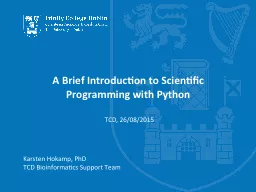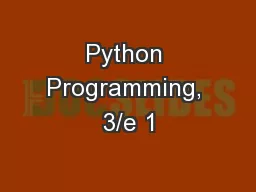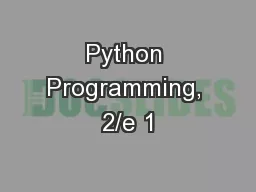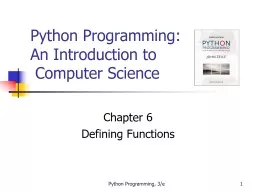PPT-A Brief Introduction to Scientific Programming with Python
Author : SweetMelody | Published Date : 2022-08-03
Karsten Hokamp PhD TCD Bioinformatics Support Team TCD 26082015 Overview Programming First Python scriptprogram Why Python Bioinformatics examples Additional resources
Presentation Embed Code
Download Presentation
Download Presentation The PPT/PDF document "A Brief Introduction to Scientific Progr..." is the property of its rightful owner. Permission is granted to download and print the materials on this website for personal, non-commercial use only, and to display it on your personal computer provided you do not modify the materials and that you retain all copyright notices contained in the materials. By downloading content from our website, you accept the terms of this agreement.
A Brief Introduction to Scientific Programming with Python: Transcript
Download Rules Of Document
"A Brief Introduction to Scientific Programming with Python"The content belongs to its owner. You may download and print it for personal use, without modification, and keep all copyright notices. By downloading, you agree to these terms.
Related Documents





![[DOWLOAD]-Python Programming for Beginners An Introduction to the Python Computer Language](https://thumbs.docslides.com/970637/dowload-python-programming-for-beginners-an-introduction-to-the-python-computer-language-and-computer-programming-python-python-3-python-tutorial.jpg)
![[FREE]-PYTHON PROGRAMMING FOR BEGINNERS Your Personal Guide for Getting into Programming,](https://thumbs.docslides.com/970688/free-python-programming-for-beginners-your-personal-guide-for-getting-into-programming-level-up-your-coding-skills-from-scratch-and-use-python-like-a-mother-language-python-programming-language.jpg)
![[BEST]-PYTHON PROGRAMMING FOR BEGINNERS: Your Personal Guide for Getting into Programming,](https://thumbs.docslides.com/975297/best-python-programming-for-beginners-your-personal-guide-for-getting-into-programming-level-up-your-coding-skills-from-scratch-and-use-python-like-a-mother-language-python-programming-language.jpg)
![[PDF]-Programming 31: Python Programming In A Day & Excel Shortcuts (Python Programming,](https://thumbs.docslides.com/979804/pdf-programming-31-python-programming-in-a-day-excel-shortcuts-python-programming-python-language-python-for-beginners-excel-programming-languages-excel-programming.jpg)
![[eBOOK]-Programming 19:C Programming Professional Made Easy & Excel Shortcuts (Excel Programming,](https://thumbs.docslides.com/980131/ebook-programming-19-c-programming-professional-made-easy-excel-shortcuts-excel-programming-microsoft-excel-python-for-beginners-c-programming-c-programming-languages-android-c-programming.jpg)
![[PDF]-Programming 3: Python Programming Professional Made Easy & C Programming Success](https://thumbs.docslides.com/980147/pdf-programming-3-python-programming-professional-made-easy-c-programming-success-in-a-day-c-programming-c-programming-c-programming-language-html-python-programming-python-java-php.jpg)
![[FREE]-Programming 16: Python Programming In A Day & C Programming Professional Made Easy](https://thumbs.docslides.com/980148/free-programming-16-python-programming-in-a-day-c-programming-professional-made-easy-c-programming-c-programming-c-programming-language-html-python-python-programming-coding-css-java-php.jpg)
![[FREE]-Programming 31: Python Programming In A Day Excel Shortcuts (Python Programming,](https://thumbs.docslides.com/988862/free-programming-31-python-programming-in-a-day-excel-shortcuts-python-programming-python-language-python-for-beginners-excel-programming-languages-excel-programming.jpg)
